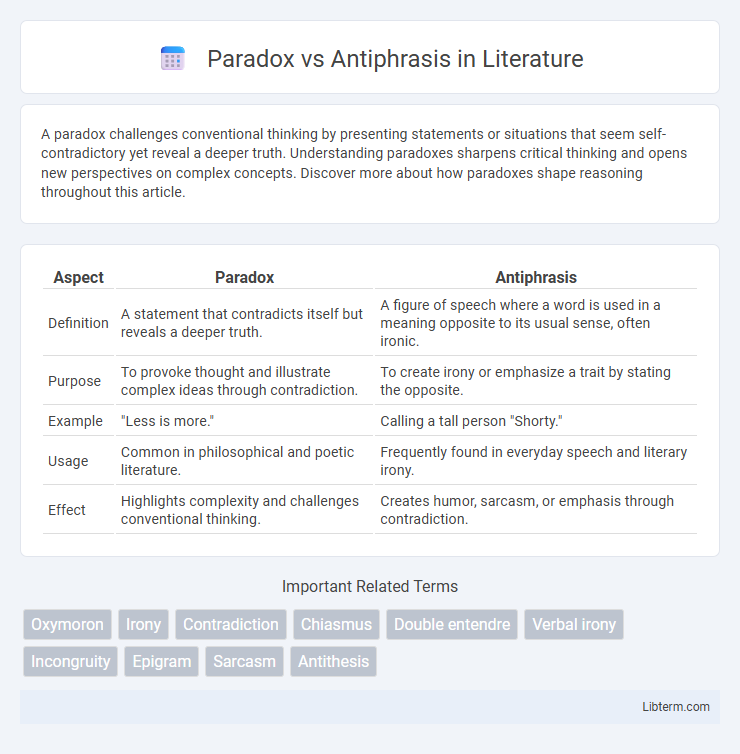A paradox challenges conventional thinking by presenting statements or situations that seem self-contradictory yet reveal a deeper truth. Understanding paradoxes sharpens critical thinking and opens new perspectives on complex concepts. Discover more about how paradoxes shape reasoning throughout this article.
Table of Comparison
| Aspect | Paradox | Antiphrasis |
|---|---|---|
| Definition | A statement that contradicts itself but reveals a deeper truth. | A figure of speech where a word is used in a meaning opposite to its usual sense, often ironic. |
| Purpose | To provoke thought and illustrate complex ideas through contradiction. | To create irony or emphasize a trait by stating the opposite. |
| Example | "Less is more." | Calling a tall person "Shorty." |
| Usage | Common in philosophical and poetic literature. | Frequently found in everyday speech and literary irony. |
| Effect | Highlights complexity and challenges conventional thinking. | Creates humor, sarcasm, or emphasis through contradiction. |
Introduction to Paradox and Antiphrasis
Paradox presents a statement that appears self-contradictory yet reveals an underlying truth, often used in literature and philosophy to challenge conventional thinking. Antiphrasis involves using a word or phrase in a sense opposite to its usual meaning, typically to create irony or humor. Understanding paradox and antiphrasis enhances critical analysis by uncovering deeper meanings beyond literal interpretations.
Defining Paradox: Meaning and Usage
Paradox is a rhetorical device that presents a statement or proposition that appears self-contradictory or logically absurd but reveals an underlying truth upon closer examination. It is commonly used in literature and philosophy to provoke thought and highlight complex realities by juxtaposing opposing ideas within a single phrase or concept. Understanding paradox involves recognizing its function to challenge conventional wisdom and encourage deeper reflection on apparent contradictions.
Understanding Antiphrasis: A Semantic Overview
Antiphrasis is a rhetorical device where a word or phrase is used in a sense opposite to its literal meaning, often for ironic or humorous effect, distinguishing it from a paradox which involves a self-contradictory statement that challenges logic. Understanding antiphrasis requires analyzing context and intent to detect the ironic discrepant meaning, as it relies heavily on semantic inversion within language use. This semantic phenomenon highlights how meaning is constructed dynamically, contrasting with paradoxes that create tension through seemingly absurd or contradictory assertions.
Historical Origins of Paradox and Antiphrasis
Paradox traces its origins to ancient Greek philosophy, especially in the works of Heraclitus and Zeno, where it was used to present contradictory yet insightful truths. Antiphrasis, emerging from classical rhetoric, derives from the Greek term meaning "opposite speech," and was popularized by orators to convey irony by stating the opposite of what is meant. Both devices have evolved through centuries of literary and rhetorical traditions, influencing how contradictory and ironic expressions are understood in historical contexts.
Paradox vs Antiphrasis: Key Differences
Paradox involves statements that appear self-contradictory but reveal deeper truths, while antiphrasis uses words opposite to their intended meaning for ironic or humorous effect. Paradox challenges readers to reconcile conflicting ideas, whereas antiphrasis relies on context to convey the intended message. Understanding these distinctions is crucial for accurately interpreting figurative language in literature and rhetoric.
Functions in Literature and Rhetoric
Paradox functions in literature and rhetoric to challenge conventional thinking by presenting seemingly self-contradictory statements that reveal deeper truths or provoke reflection. Antiphrasis serves to inject irony or humor by using words in a sense opposite to their literal meaning, often highlighting contrast or criticism. Both devices enrich language by engaging readers to decipher layered meanings and enhancing persuasive or expressive impact.
Common Examples of Paradox in Writing
Common examples of paradox in writing include statements like "less is more," highlighting how simplicity can lead to greater impact, and "this is the beginning of the end," which combines conflicting ideas to provoke thought. Paradoxes often appear in literature and philosophy to challenge conventional wisdom and reveal deeper truths. Writers use paradox to create tension and emphasize complexities within human experience.
Illustrative Examples of Antiphrasis
Antiphrasis involves using words in a sense opposite to their literal meaning for ironic or humorous effect, as seen in phrases like calling a tall person "Shorty" or labeling a messy room as "neat." This rhetorical device contrasts with paradox, which presents seemingly contradictory statements that reveal deeper truths, such as "less is more." Common examples of antiphrasis highlight irony through intentional misnaming and exaggerate characteristics to emphasize a point vividly.
Impact on Reader Interpretation
Paradox challenges readers by presenting seemingly contradictory statements that provoke deeper reflection and reveal complex truths, enriching interpretation through cognitive dissonance. Antiphrasis relies on irony or opposite meanings to create humor or emphasize a point, often guiding readers to perceive underlying sarcasm or critique. The impact on reader interpretation varies as paradox invites contemplative analysis, while antiphrasis triggers recognition of irony and shifts in contextual understanding.
Choosing Between Paradox and Antiphrasis
Choosing between paradox and antiphrasis depends on the intended rhetorical effect: paradox presents a seemingly contradictory statement that reveals a deeper truth, while antiphrasis employs irony by using words to mean the opposite of their literal sense. Writers should analyze the context to determine if the aim is to provoke thought through complex contradictions or to create humor and emphasis via ironic understatement. Understanding the distinction enhances clarity and impact in literary and persuasive writing.
Paradox Infographic

 libterm.com
libterm.com